ASTM F756 Hemolysis Testing of Medical Device Materials
The ASTM F756 standard provides a standardized method to evaluate the hemolytic potential of materials used in medical devices. This test is particularly important for ensuring that materials do not cause harm when they come into contact with blood or other bodily fluids during use. Hemolysis, which refers to red blood cell lysis, can lead to serious health issues if the material's interaction with biological systems is not properly controlled.
The ASTM F756 test involves exposing a standardized solution of human red blood cells (RBCs) to the test specimen under defined conditions. The change in hemoglobin concentration, measured as an increase or decrease, indicates the degree of hemolysis caused by the material. This method is critical for ensuring that medical devices are safe and do not pose risks to patients.
The process begins with careful selection of the test specimen, which should accurately represent the medical device's intended contact surface. The RBC suspension used in this test must be prepared according to strict specifications provided by ASTM F756. Once the setup is complete, the specimens are incubated for a specific duration, followed by centrifugation and spectrophotometric analysis of the supernatant.
The results are analyzed based on hemoglobin concentration changes, with acceptance criteria defined in ASTM F756 to determine whether the material passes or fails. This test is essential for regulatory compliance and ensuring that medical devices meet safety standards before they can be marketed.
| ASTM F756 Hemolysis Testing Parameters | |
|---|---|
| Test Specimen Preparation: | Standardized according to ASTM F756 guidelines. |
| Hemoglobin Concentration Measurement: | Spectrophotometric analysis of the supernatant after incubation and centrifugation. |
| Instrumentation: | Centrifuge, spectrophotometer. |
| Acceptance Criteria: | Defined in ASTM F756 based on hemoglobin concentration change. |
The ASTM F756 test is widely recognized and used by medical device manufacturers to ensure the safety of their products. It provides a reliable method for evaluating potential risks associated with materials used in medical devices, thereby protecting patient health and well-being.
Applied Standards
The ASTM F756 hemolysis testing is governed by several international standards that ensure the accuracy and reliability of the test. The most commonly referenced standard for this type of testing is:
- ASTM F756-18 Standard Test Method for Determining Hemolytic Potential of Medical Device Materials
In addition to ASTM, other relevant standards include ISO 10993 series for biocompatibility evaluation and EN 45591 for medical device materials. Compliance with these standards is crucial for ensuring that the testing meets global regulatory requirements.
The ASTM F756 standard defines clear procedures for conducting hemolysis tests, including specimen preparation, incubation conditions, analysis methods, and acceptance criteria. These guidelines are essential for maintaining consistency and comparability in test results across different laboratories and manufacturers.
Why Choose This Test
- Regulatory Compliance: ASTM F756 is a widely accepted standard that ensures compliance with international regulations.
- Patient Safety: Ensures medical devices do not induce hemolysis, thus protecting patient health.
- Risk Reduction: Identifies potential risks early in the development process, minimizing the need for costly revisions later.
- Data Validity: Provides robust and reproducible data that supports decision-making throughout product development.
The ASTM F756 hemolysis test is a critical step in ensuring medical devices are safe and effective. By choosing this test, manufacturers can demonstrate their commitment to quality and patient safety while meeting regulatory requirements.
Use Cases and Application Examples
| Use Case | Description |
|---|---|
| Medical Device Development: | Evaluating the hemolytic potential of new materials used in medical devices. |
| Material Selection: | Selecting appropriate materials for use in medical devices that will come into contact with blood or bodily fluids. |
| R&D Validation: | Validating the safety of existing products by testing new versions against ASTM F756 standards. |
| Compliance Verification: | Ensuring compliance with international standards for medical device materials. |
The ASTM F756 hemolysis test is applicable to a wide range of medical devices, including implants, catheters, and other devices that come into direct contact with the body. It helps manufacturers ensure that their products do not pose a risk to patients by identifying potential hemolytic effects early in the development process.





